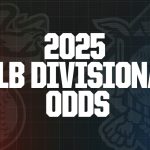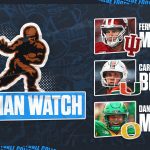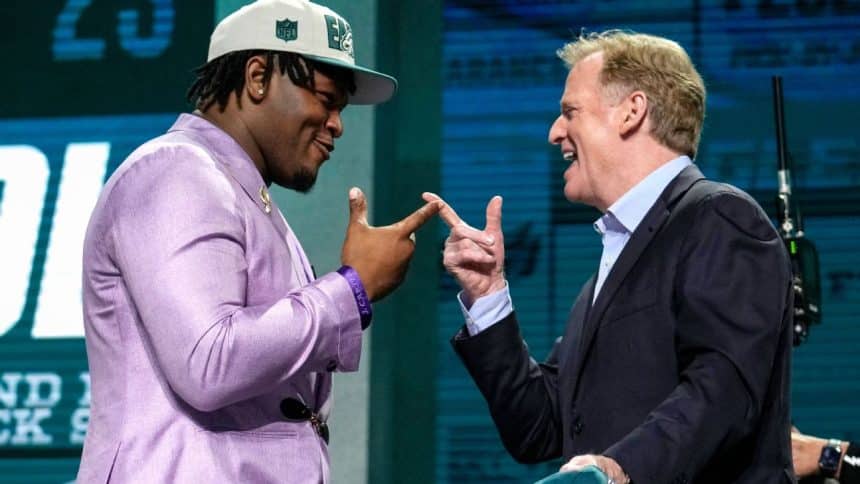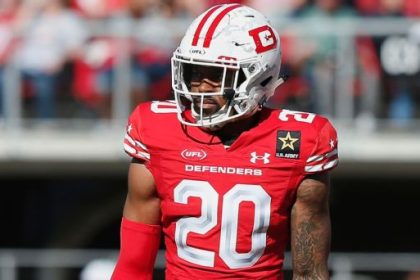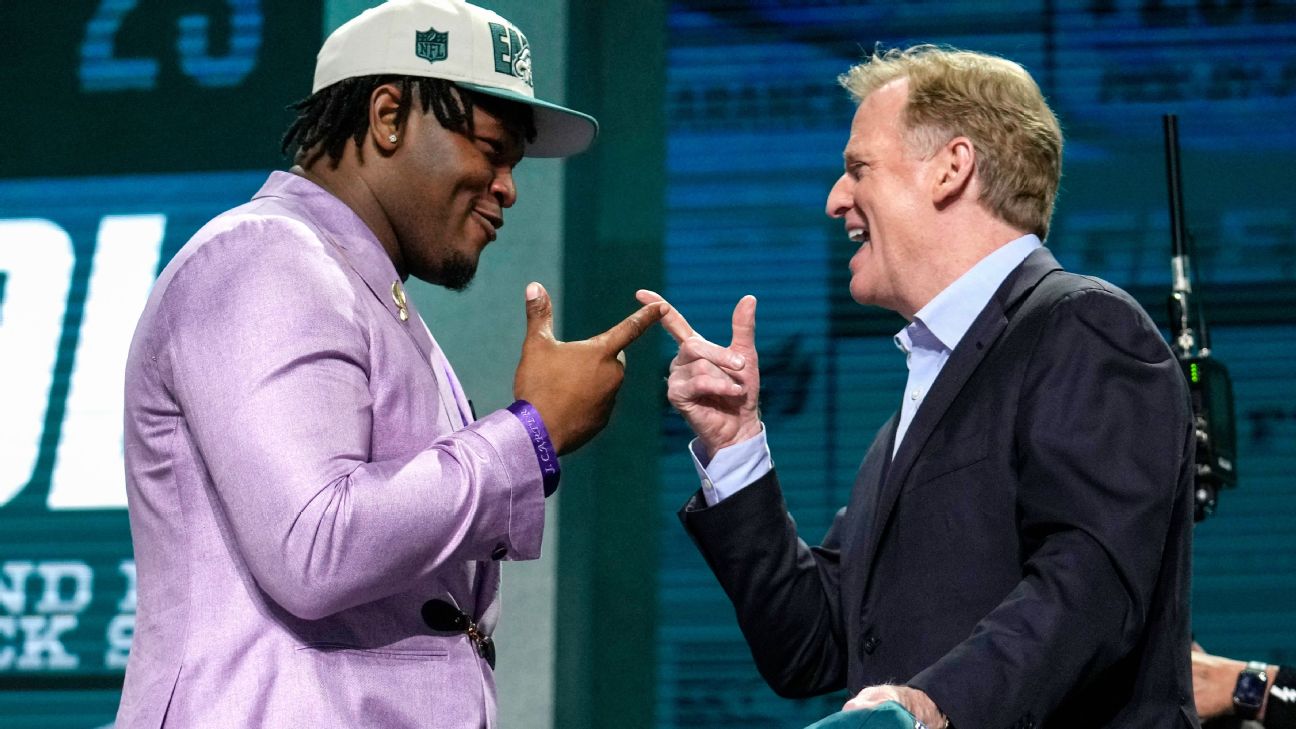
The 2023 NFL draft began Thursday, with the Carolina Panthers selecting Alabama quarterback Bryce Young with the No. 1 overall pick.
We will be tracking all 259 picks for Rounds 1-7, and you also can check out all the best available draft prospects.
The draft continues with Rounds 2-3 on Friday (7 p.m. ET) and concludes with Rounds 4-7 on Saturday (noon ET).
Here are pros and cons for each of the 31 players selected in Thursday’s first round:
![]() coverage:
coverage:
McShay’s draft week buzz
Consensus position rankings
Three-round mock draft

![]()
Bryce Young, QB, Alabama | Highlights
Why they picked him: He’s a difference-maker, something the Panthers haven’t had at quarterback since midway through the 2018 season when Cam Newton began having injury issues. Young’s ability to process, as Alabama coach Nick Saban said, is “off the charts.” That should enable Young to be ready to start Day 1. His mobility and ability to make plays when protection breaks down is second to none. Young ranked first the past two seasons in passing yards (2,132), touchdowns (24) and completions of 20-plus yards (34) when under pressure. He had the highest Total QBR rating outside the pocket (95.7) in 2022 among the 98 FBS quarterbacks who attempted at least 250 passes. Young displays leadership on and off the field, something the Panthers want in the face of the franchise and coach Frank Reich ranks high on traits he seeks in a quarterback.
Biggest question: His size, at 5-foot-10 and 204 pounds. There really isn’t a history of successful NFL quarterbacks under 6-foot outside of Russell Wilson (5-11) and Kyler Murray (5-10). But it’s not so much the height that is a concern. It’s the durability. The Panthers already have a plan in place to put weight on Young and bulk him up. “Nutritionally, we can do some things to educate him, get him in the weight room,” said Panthers GM Scott Fitterer, who was in Seattle when Wilson was drafted in 2012. But what lessens the concern here is Young’s unique ability to avoid the big hits in the way running back Barry Sanders (5-8, 200) did during his Hall of Fame career. These are reasons size didn’t outweigh the positives Young brings. — David Newton
![]()
C.J. Stroud, QB, Ohio State | Highlights
Why they picked him: The hope is Stroud can be the driving force to get the Texans back to respectability and stabilize the quarterback position. Last season, the Texans’ QB room had a QBR of 26, last in the NFL and the second most interceptions with 19. In two seasons as starter at Ohio State, Stroud threw for 8,123 yards, 85 touchdowns and 12 interceptions. He was a Heisman Trophy finalist in 2021 and ’22.
Biggest question: How good can Stroud be without top-tier playmakers to start his career? During his Ohio State career, he was loaded with elite receiving talents led by the New York Jets‘ Garrett Wilson and the Saints’ Chris Olave. Wilson and Olave both were 1,000-yard receivers as rookies. — DJ Bien-Aime
![]()
Will Anderson Jr., LB, Alabama | Highlights
Why they picked him: The Texans’ defense ranked 27th in points allowed (24.7) and 30th in total defense (379.5 yards per game) in 2022. It was one of the worst run defenses ever, as it also allowed the sixth-most rushing yards for a single season (2,894 yards). The Texans needed defensive help, and Anderson is viewed as one of the better players in this draft. During his three-year career at Alabama, he finished with 58.5 tackles for loss, 34.5 sacks and 204 tackles.
Biggest question: Will Anderson played outside linebacker in college in a 3-4 defense. Texans coach DeMeco Ryans runs a 4-3, so instead of mainly standing up at the line of scrimmage as he did in college, Anderson will have to play with his hand in the dirt most of the time. But that shouldn’t be too much of an issue. — DJ Bien-Aime
![]()
Anthony Richardson, QB, Florida | Highlights
Why they picked him: The Colts have been laser focused on the quarterbacks in this draft from the start. They had to solve this lingering problem that has existed since Andrew Luck’s sudden retirement in 2019. The Colts struck out with potential solutions in veterans Jacoby Brissett, Philip Rivers, Carson Wentz and Matt Ryan. Richardson represents the biggest draft investment at the position since Luck was drafted in 2012. Schematically, Richardson is a good fit for first-year Colts coach Shane Steichen, who helped maximize a mobile quarterback in Jalen Hurts the past two seasons as Philadelphia Eagles offensive coordinator.
Biggest question: How quickly can Richardson develop? Having started 13 games at Florida, Richardson is considered a raw prospect who will need to show more consistency on routine throws. His 53.8% completion rate last season raises lots of questions, but Colts GM Chris Ballard said Thursday the team can develop him in this area. As for whether Richardson will play as a rookie, Ballard was noncommittal. But he didn’t rule out a big or small role for the 20-year-old prospect. — Stephen Holder
![]()
Devon Witherspoon, CB, Illinois | Highlights
Why they picked him: The Seahawks had to bolster a defense that’s been their Achilles’ heel for several seasons, but this pick defied most projections because Seattle’s much bigger need is up front and not in the secondary. Witherspoon was the Seahawks’ guy despite their other defensive holes and despite his smaller frame, at 5-foot-11 1/2, 181 pounds and arms that don’t quite meet their usual standard of 32 inches. Witherspoon, a physical player who’s widely regarded as the top corner in this draft, makes a good secondary even better. With Tariq Woolen coming off a Pro Bowl rookie season, Seattle now has the makings of an elite CB tandem.
Biggest question: Should the Seahawks have taken Jalen Carter or Tyree Wilson to address their biggest need on defense. Passing on Carter — arguably the most talented defender in the draft — is a clear indication they weren’t comfortable with his off-the-field issues. They might have passed on Wilson because of questions about how well he’d fit into their scheme. Either way, they badly need to add more impact players along their defensive line, and at least one at outside linebacker. But they have another first-rounder (20) as well as two second-rounders. — Brady Henderson
![]()
Paris Johnson Jr., T, Ohio State | Highlights
Why they picked him: Johnson is the kind of offensive lineman the Cardinals not only need but can play immediately. He played left tackle last season but was a guard prior to that at Ohio State. With the Cardinals’ offensive line full of holes, Johnson Jr. will be able to fill one and could end up being the left tackle of the future for Arizona.
Biggest question: Where will he play? Johnson is versatile, so how Arizona utilizes him will be among the most-watched storylines of the offseason. Is he a Day 1 left tackle who will replace D.J. Humphries? Is he a guard? Only time will tell. — Josh Weinfuss
![]()
Tyree Wilson, DE, Texas Tech | Highlights
Why they picked him: Simply put, he was the best player available on the Raiders’ board. Sure, cornerback may be a bigger need, per se, but if Wilson is able to affect opposing quarterbacks, as he is projected to do, the pass rush will also help the corners in coverage. General manager Dave Ziegler and coach Josh McDaniels said ahead of the draft they would not be afraid to make a strength even stronger. And while the defense has holes — it was the No. 28-ranked total D in the NFL — the pass rush of Maxx Crosby was a strength, and Wilson can learn at the knee of veteran edge rusher Chandler Jones.
Biggest question: While Wilson is coming off consecutive seven-sack seasons, the 6-foot-6, 271 pound edge rusher is also coming off a fractured right foot. So will there be lingering issues? He did not work out at the combine or Texas Tech’s Pro Day. The Raiders don’t see it as a long-term problem, obviously, and here we are. — Paul Gutierrez
![]()
Bijan Robinson, RB, Texas | Highlights
Why they picked him: The Falcons have always said they would go best player available — and with who was left on the board, Robinson was just that. The running back from Texas might be the best player in the draft, period. It’s an unconventional pick, but the Falcons don’t believe in convention after taking tight end Kyle Pitts at No. 4 in 2021. Now, Atlanta has elite players on offense on rookie contracts.
Biggest question: There aren’t many questions. Robinson is a clear high-level prospect and one of the safest players in the draft. How he’ll be used is perhaps the biggest wonder — he has clear pass-catching ability, so he could end up being the eventual replacement for Cordarrelle Patterson and a great one-two punch with Tyler Allgeier. — Michael Rothstein
![]()
Jalen Carter, DT, Georgia | Highlights
Why they picked him: Carter, arguably the top prospect in the draft, slipped due to off-field concerns. A disruptive force in the middle, he garnered All-American honors in 2022 with three sacks and seven tackles for loss. With Fletcher Cox and Brandon Graham on the back end of their careers, Carter ensures the Eagles’ defensive front will remain strong.
Biggest question: In March, Carter pleaded no contest to misdemeanor charges of reckless driving and racing. He was nine pounds heavier at his pro day than he was at the NFL combine about two weeks prior and couldn’t finish his position drills. With two of his former Georgia teammates — Jordan Davis and Nakobe Dean — on the roster, and with the Eagles’ strong veteran leadership in the locker room, the belief is that Carter is entering the right atmosphere to be successful. — Tim McManus
![]()
10. Chicago Bears (from Philadelphia via New Orleans)
Darnell Wright, T, Tennessee | Highlights
Why they picked him: Bears quarterback Justin Fields was sacked 55 times last season. Chicago allowed pressure on 39.5% of dropbacks, worst in the NFL. Wright started 42 games over four seasons at Tennessee where he played 64% of snaps at right tackle and allowed one sack in 454 pass blocking snaps in 2022. The Bears liked the fact he also played left tackle and right guard.
Biggest question: Does drafting Wright signal the Bears’ belief Braxton Jones, who played every snap on offense in 2022, is best suited to stay at left tackle? Jones allowed 40 pressures last season (seven sacks in 542 pass blocking snaps) and got a vote of confidence from the Bears this offseason to remain at left tackle “for now,” according to GM Ryan Poles. Wright has positional flexibility and the traits that Chicago covets in terms of his length and size (6-foot-5, 333 pounds) and speed after he ran a 5.01 in the 40-yard dash at the combine, the fourth-fastest 40 time in Indianapolis by any player weighing at least 330 pounds since at least the start of 2006. — Courtney Cronin
![]()
Peter Skoronski, OL, Northwestern | Highlights
Why they picked him: The Titans’ offensive line allowed 49 sacks last season. Although it added free agents Daniel Brunskill and Andre Dillard, Tennessee still has a need along the offensive line. Skoronski is a technically sound player who could slide in at left guard but also provide an option as a future left tackle. Guard might not be a high-profile position, but it has a higher value to a team like the Titans that relies so heavily on running the ball.
Biggest question: Which position will he play? Skoronski started all 24 games at left tackle over the past two seasons. Tennessee signed Dillard, who said he expects to compete for the starting left tackle position. Skoronski could be an instant starter at left guard. — Turron Davenport
![]()
12. Detroit Lions (from Arizona via Houston through Cleveland)
Jahmyr Gibbs, RB, Alabama | Highlights
Why they picked him: After an unpredictable start to the draft, the Lions traded their sixth overall pick to receive picks No. 12 and No. 34 from Arizona and decided to upgrade their top-ranked offense with Alabama’s Gibbs. After losing Jamaal Williams via free agency, Detroit will pair him with D’Andre Swift and David Montgomery for a strong backfield.
Biggest question: Detroit could’ve gone in a number of directions, on the defense with a pass-rusher or cornerback. However, the Lions decided to address the running back spot. They had a shot at defensive prospects at the No. 6 pick, such as Tyree Wilson and Jalen Carter, but went with a multidimensional offensive threat despite the defense ranking at the bottom of the league. — Eric Woodyard
![]()
Lukas Van Ness, DE, Iowa | Highlights
Why they picked him: Because don’t the Packers always go with defense in the first round? This makes it 12 of the past 13 Packers first-round picks on defense with the only outlier coming in 2020 when they drafted quarterback Jordan Love. With Rashan Gary coming off an ACL tear last November, this gives the Packers another pass-rusher in case Gary isn’t ready. Throw in Preston Smith and the Packers hope they have three legitimate edge players.
Biggest question: Why didn’t the Packers help Love? Maybe they did with this pick. If Packers defensive coordinator Joe Barry has enough pieces to control games, then Love won’t have to throw the ball 35 times a game. Besides, without a receiver or tight end off the board before this pick, the Packers will have a better chance to get a high-rated pass-catcher with one of their next picks. — Rob Demovsky
![]()
Broderick Jones, T, Georgia | Highlights
Why they picked him: With the top-tier offensive tackles evaporating, Steelers general manager Omar Khan made the aggressive move to trade with the Patriots to secure protection for quarterback Kenny Pickett, last year’s first-round pick. Jones started 19 of 32 career games at Georgia and is an upgrade over the Steelers’ current starting tackle tandem of Chukwuma Okorafor and Dan Moore Jr. Not only does Jones bolster their quarterback protection, his addition also is a boost to the run game — something that didn’t get going until after the midseason bye in 2022.
Biggest question: Will Jones replace Okorafor or Moore? Jones spent most of his time at left tackle during his collegiate career. Neither Okorafor nor Moore ranked in the top 10 in ESPN’s pass block win rate or run block win rate. But as a unit, the Steelers ranked No. 14 in run block win rate and No. 7 in pass block win rate. Even so, the Steelers wouldn’t make an aggressive move for a tackle they didn’t view as an early starter, it’s just a matter of which tackle he unseats. — Brooke Pryor
![]()
Will McDonald IV, LB, Iowa State | Highlights
Why they picked him: When in doubt, take an edge rusher, right? McDonald joins a talented group of defensive ends, including 2022 first-round pick Jermaine Johnson. The Jets really needed an offensive tackle, but the top four linemen were off the board. The Steelers leap-frogged the Jets, moving to No. 14 to take Broderick Jones — a Jets target. Dropping two spots as part of the Aaron Rodgers trade — 13 to 15 — cost the Jets a quality lineman. They pivoted to McDonald.
Biggest question: How does McDonald get on the field? At DE, the Jets have Carl Lawson, John Franklin-Myers, Johnson, Bryce Huff and Micheal Clemons. Coach Robert Saleh likes to rotate, but this is absurd. You have to wonder is another move is coming. Lawson carries an $15.7 million cap charge, so his status bears watching. — Rich Cimini
![]()
Emmanuel Forbes, CB, Mississippi State | Highlights
Why they picked him: The Commanders needed a playmaker. Forbes tied for third in the nation with five interceptions and led the country by returning three for touchdowns. Forbes intercepted passes off tipped balls and bad throws. The Commanders liked how well he read the quarterback and his route recognition, allowing him to be effective in their zone match system. The Commanders like their current corners Benjamin St-Juste and Kendall Fuller, but they’re not ballhawks. Getting Forbes, behind a line that can pressure the passer, should lead to more big plays.
Biggest question: How will he hold up? Forbes is a thinner corner, having played last season at 166 pounds. He has bulked up to 180 this offseason. It was not an issue in the SEC, where Forbes played 35 games in three seasons. But it also will be a factor against the run. Washington will require its corners to play the run and, while Forbes is willing, it could take a toll. — John Keim
![]()
17. New England Patriots (from Pittsburgh)
Christian Gonzalez, CB, Oregon | Highlights
Why they picked him: The Patriots traded down from 14 with the Steelers and picked up the 17th pick, in addition to a fourth-rounder (120). In doing so, they still landed what some scouts and analysts believed is the top cornerback in the draft. Gonzalez, 6-foot-2, should complement the team’s current CB group, which is smaller in stature. That size and speed, which gives Gonzalez No. 1-CB potential, has a chance to help when it comes to matching up with bigger receivers, and possibly tight ends. Gonzalez joins Jonathan Jones, Marcus Jones and Jack Jones atop the CB depth chart.
Biggest question: The Patriots demand physicality from their cornerbacks, who play a big role in run force. That is an area that scouts say is still developing in Gonzalez’s game. — Mike Reiss
![]()
Jack Campbell, ILB, Iowa | Highlights
Why they picked him: They had to go defense, right? After using the No. 12 pick to grab Alabama running back Jahmyr Gibbs, Detroit addressed its defense with Campbell, who was named the 2022 Butkus Award winner as the nation’s top linebacker. Campbell had 143 tackles in 2021, fifth most in a season at Iowa.
Biggest question: The question is whether he should have been selected this high. But he certainly addresses a major need on the roster. Campbell rushed the passer on only 14% of snaps and struggled in coverage, allowing 13 completions on 17 attempts when he was targeted in 2022. — Eric Woodyard
![]()
Calijah Kancey, DE, Pittsburgh | Highlights
Why they picked him: The Bucs didn’t re-sign Akiem Hicks in free agency, and Kancey has drawn comparisons to Aaron Donald — a player Bucs general manager Jason Licht had the chance to draft in 2014 (and the team was high on), but they selected receiver Mike Evans instead (hey, that still worked out pretty well).
Biggest question: The Bucs passed on the chance to draft left tackle Anton Harrison or quarterbacks Will Levis or Hendon Hooker. It remains to be seen if those areas will be addressed. One could argue it’s difficult for defensive tackles to make an impact right away, and the Bucs need sack production, with Vita Vea leading the team with 6.5 sacks last year. — Jenna Laine
![]()
Jaxon Smith-Njigba, WR, Ohio State | Highlights
Why they picked him: The Seahawks needed a third receiver behind Tyler Lockett and DK Metcalf and didn’t have an obvious candidate on the roster. Lockett will also be 31 in September, so there’s reason to fortify the position long term. But this doesn’t feel like a pick based mostly on need. Even with the questions about his top-end speed, Smith-Njigba is widely considered the top receiver in this draft, with some projections having him off the board several picks earlier. So this could be a nice value pick in addition to one that plugs immediate and long-term holes.
Biggest question: Where will he fit into their offense? Smith-Njigba is known as an excellent route-runner who’s much quicker than he is fast. He didn’t run the 40 at the scouting combine while recovering from the hamstring injury that sidelined him for all but three games last season. At his pro day, he reportedly ran in the high-4.4/low-4.5 range. That raises a question of whether he’s best suited to play in the slot or if he can also line up wide. — Brady Henderson
![]()
Quentin Johnston, WR, TCU | Highlights
Why they picked him: The Chargers feature wide receivers Keenan Allen and Mike Williams but need a playmaker who is capable of stretching the field for quarterback Justin Herbert. That is exactly what Johnston provides, as a deep threat who possesses the ability to track and catch the football over his shoulder. His 533 yards after the catch last season were 83 more than any other Big 12 wide receiver and ranked 11th overall among FBS wideouts.
Biggest question: How quickly can Johnston learn the offense? He’s needed immediately for the Chargers’ offense to realize its full potential in 2023. — Lindsey Thiry
![]()
Zay Flowers, WR, Boston College | Highlights
Why they picked him: The Ravens continue to go all-in for quarterback Lamar Jackson and the passing attack. Hours after making Jackson the highest-paid quarterback in the NFL at $52 million per season, Baltimore gave him his third new wide receiver of the offseason. The Ravens add Flowers, the No. 1 wide receiver on Mel Kiper’s board, to go along with free-agent signings Odell Beckham Jr. and Nelson Agholor. Flowers can stretch the field, scoring nine touchdowns off post routes, which were tied for most in the FBS. That will help a Ravens passing game that produced 11 completions on passes that traveled at least 20 yards in the air (fourth fewest in the NFL) last season.
Biggest question: Will the Ravens reverse their track record at wide receiver? Baltimore has failed to consistently stretch the field even though the team has invested first-round picks on wide receivers in 2019 (Marquise “Hollywood” Brown) and 2021 (Rashod Bateman). The Ravens have ranked last in the NFL in receiving yards by wide receivers in three of the past four seasons (2019, 2020 and 2022). Of the 31 wide receivers drafted by Baltimore — including five previously in the first round — two have recorded 1,000-yard seasons (Torrey Smith and Brown) and none have gone to the Pro Bowl, which is the longest current drought in the NFL. There are concerns about Flowers’ size (5-foot-9, 182 pounds), but he is tenacious with the ball in his hands. He forced 25 missed tackles last season, the third most in the country for a wideout. — Jamison Hensley
![]()
Jordan Addison, WR, USC | Highlights
Why they picked him: The departure of longtime starter Adam Thielen created an obvious hole. Veteran K.J. Osborn has been expected to slide into Thielen’s role, but the Vikings were predominantly a three-receiver offense under coach Kevin O’Connell last season. Justin Jefferson, Osborn, Addison and possibly 2022 draft pick Jalen Nailor would be expected to fill those spots in 2023.
Biggest question: While you can never have too many offensive playmakers, the Vikings’ decision to sit and wait for Addison means they likely won’t have a quarterback to groom as a successor to Kirk Cousins, whose contract expires after the 2023 season. They could have drafted either Will Levis or Hendon Hooker at No. 23, but clearly they did not consider either player to be worthy. They don’t have a second-round pick, either. — Kevin Seifert
![]()
Deonte Banks, CB, Maryland | Highlights
Why they picked him: The Giants needed a cornerback on the outside. Adoree’ Jackson is their only proven player there and is on the final year of his deal plus has an extensive injury history. Banks is a player the Giants were hoping was available at pick No. 25. He has the ideal size (6-foot, 197 pounds), strength, speed (4.35, 40) to be a standout cornerback in Wink Martindale’s defense.
Biggest question: Banks has to show that he has the ball skills to be a No. 1 shutdown corner. That is what the Giants ultimately need. All the skills are there. Banks had just two interceptions in his college career. — Jordan Raanan
![]()
25. Buffalo Bills (from Jacksonville via N.Y. Giants)
Dalton Kincaid, TE, Utah | Highlights
Why they picked him: The Bills were looking for another offensive playmaker. Kincaid was the top player remaining on the team’s board, prompting it to move up to get him. General manager Brandon Beane described Kincaid as having “elite hands” and said he adds a different skill set than tight end Dawson Knox. The Bills tight ends combined for 57 receptions last season, 29th in the NFL. Kincaid, who led all FBS tight ends with 70 catches in 2022, becomes the first offensive player drafted by the Bills in the first round since Josh Allen.
Biggest question: Was trading up for a tight end in the first round really worth it? The Bills gave up a fourth-round pick to pick Kincaid, jumping ahead of the Dallas Cowboys to do so. The Bills now have four picks remaining and a need for a bigger draft class. While Kincaid has had success as a receiver, and the Bills led the NFL in drops last year, how the offense will look and work with him and Knox remains to be seen. Kincaid also is coming off a back injury, but said he expects to come in and be able to participate. — Alaina Getzenberg
![]()
Mazi Smith, DT, Michigan | Highlights
Why they picked him: The Cowboys want to help their run defense, and Smith gives the defense some anchor at 6-foot-3, 323 pounds. He started the final 28 games of his career at Michigan with 85 tackles, five for loss, a half sack, four pass deflections and one forced fumble. The Cowboys ranked 22nd in run defense a year ago. They re-signed Johnathan Hankins and have Quinton Bohanna, but Smith has the ability to be a plugger and keep blockers off their linebackers.
Biggest question: Does he have pass-rushing ability to make him a three-down player? The Cowboys have been reluctant to take defensive tackles because they wanted well-rounded players. The last time they took a defensive tackle in the first round was Russell Maryland in 1991, who went first overall. Smith had a half sack for his career, but the Cowboys do have a varied pass rush with Micah Parsons, DeMarcus Lawrence, Dorance Armstrong, Sam Williams and Dante Fowler Jr.. — Todd Archer
![]()
Anton Harrison, T, Oklahoma | Highlights
Why they picked him: With the uncertainty surrounding the status of left tackle Cam Robinson — he’s facing a potential six-game suspension for violating the NFL’s substance-abuse policy — and the likelihood this is his final season in Jacksonville, the Jaguars added his replacement a year early. Harrison played mainly left tackle at Oklahoma but did spend some time on the right side, which gives the Jaguars some flexibility during Robinson’s potential suspension as well as in 2024. The Jaguars could start him at left tackle or have Walker Little move from right tackle to left and install Harrison as the right tackle. Harrison allowed one sack on 772 pass blocks over the past two seasons and two pressures on 406 pass block snaps last season, per ESPN Stats & Information.
Biggest question: Pass rush is a major need for the Jaguars, and edge rusher Nolan Smith was available when the Jaguars picked Harrison — even after they moved back twice from No. 24 in trades with the Giants and Bills. But Jaguars GM Trent Baalke believed Harrison’s versatility — he can also play guard — was too much to pass up. — Michael DiRocco
![]()
Myles Murphy, DE, Clemson | Highlights
Why they picked him: The Bengals like to prioritize two positions in the first round when it comes to defensive guys — edge rushers and cornerbacks. Murphy gives the Bengals another defensive end to supplement their current pass rushing attack. He had 18 sacks over the past three seasons (second most in the ACC over that span). The Bengals recorded a sack on 5% of dropbacks last season, fourth lowest in the NFL.
Biggest question: What does this mean for the future of the two players entrenched on the edge, Sam Hubbard and Trey Hendrickson? The Bengals are about to have to spend key resources on offensive players (Joe Burrow, Tee Higgins and Logan Wilson), so Murphy will help Cincinnati offset those costs. — Ben Baby
![]()
29. New Orleans Saints (from San Francisco through Miami and Denver)
Bryan Bresee, DT, Clemson | Highlights
Why they picked him: The Saints were able to stay put at 29 and fill one of their biggest needs after they lost multiple players on the interior of the defensive line. Bresee was able to generate an interior pass rush at Clemson with nine career sacks, and while the Saints did sign free agents to replace David Onyemata and Shy Tuttle, the newcomers will likely take up more of a run-stopping role. Bresee will likely be someone who can rotate into the defensive line right away.
Biggest question: Bresee dealt with multiple injuries in college, including a torn ACL and injured shoulder, but played 10 games in 2022. Injuries have been a problem for the Saints for the last two seasons, and at times they held back the development of pass rushers Marcus Davenport and Payton Turner. However, Bresee is now two years removed from the 2021 knee injury and will be able to participate in practice right away. — Katherine Terrell
![]()
Nolan Smith, OLB, Georgia | Highlights
Why they picked him: Philadelphia is now Georgia south. After drafting Jalen Carter at No. 10 and selecting fellow Bulldogs Jordan Davis and Nakobe Dean the year prior, the Eagles went with Smith, an edge rusher that has similar size, speed and skills as Haason Reddick. A unit that posted a league-leading 70 sacks last season adds another player who can affect the quarterback.
Biggest question: Why did Smith drop? He was projected to go in the first half of the first round — some mocks had him going to Philadelphia at 10 — but he dropped to the bottom of the round. He did suffer a season-ending torn pectoral muscle in October and is on the lighter side for his position at 238 pounds. — Tim McManus
![]()
Felix Anudike-Uzomah, DE, Kansas State | Highlights
Why they picked him: Despite drafting George Karlaftis in the first round last year and signing Charles Omenihu in free agency this year, the Chiefs needed help on the edge. Anudike-Uzomah had 19.5 sacks and 30.5 tackles for loss over the last two seasons. They plan to move Omenihu inside to pair with Chris Jones as an interior rusher on passing downs, so a spot is open for Anudike-Uzomah to claim a spot opposite Karlaftis on the edge on passing downs.
Biggest question: What about wide receiver? The Chiefs watched as four straight wide receivers were picked a few spots ahead of them. Could they have traded up to get one of them? — Adam Teicher




